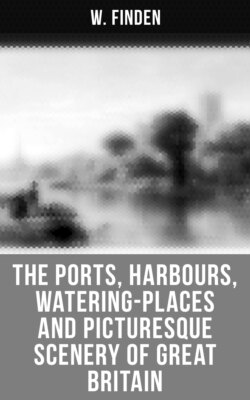Читать книгу The Ports, Harbours, Watering-places and Picturesque Scenery of Great Britain - W. Finden - Страница 20
На сайте Литреса книга снята с продажи.
SUNDERLAND,
THE LIGHTHOUSE ON THE SOUTH PIER.
ОглавлениеTable of Contents
The view of the Lighthouse on Sunderland South Pier is taken from the south-east. The entrance to the harbour lies beyond the pier-head, to the right, on which a crane, and a capstan used in warping out ships, are perceived. The large D on the fore-topsail of the collier lying within the pier is a distinguishing mark adopted by the owner that his vessels may be more readily known. To the left is seen the higher lighthouse, of stone, which stands on the north pier, on the opposite side of the river.
The erection of a pier on each side of the entrance to Sunderland harbour has been rendered necessary in consequence of the constant tendency of the bar of sand at its mouth to accumulate. The piers, by contracting the channel of the river, have deepened the water, and increased the velocity of the current at ebb tide, which thus scours the entrance to the harbour, and prevents the accumulation of sand upon the bar.
In 1669, Charles II. granted letters patent to Edward Andrew, Esq., empowering him to build a pier, erect lighthouses, and cleanse the harbour at Sunderland, and also to raise funds for these purposes by a tonnage-duty on ships. At a subsequent period, commissioners were appointed for the same purposes by an act of parliament; and under their authority three hundred and thirty-three yards of the north pier were built, between 1716 and 1746. From a report of the commissioners made in 1765, it appears that £50,000 had been expended on the south pier up to that time, and it was estimated that to finish it would cost as much more. It is now extended to the length of six hundred and twenty-five yards. The north pier, which is entirely of stone, was commenced about 1785, but additions have been recently made to its eastern extremity.
The lighthouse on the north pier was erected in 1803. The light, which is stationary, is exhibited from sunset to sunrise, and is visible in clear weather at the distance of twelve miles. The light on the south pier is a tide light, and is only shown when there is sufficient depth of water on the bar for ships to enter. This light is of a red colour. By day a flag is hoisted during tide-time.
Since the year 1200—and probably from a much earlier period—the harbour at the mouth of the Wear appears to have been generally known as that of Sunderland, the present name of the port and of the parliamentary borough. "Various conjectures," says Mr. Surtees, "have been formed as to the derivation of this name; the simplest and most obvious seems to be, that it marked the original situation of the place on a point of land almost insulated by the Wear and by the sea, which has probably flowed much higher than at present up some of the deep gullies on the coast, particularly Hendon-Dene, which, it seems, contained, as late as 1350, water sufficient for vessels to ride at anchor in the bay."
In 1719 an express distinction was made by an act of parliament, which constituted Sunderland a separate parish from that of Bishop-Wearmouth, in which it had formerly been included. This act was passed on the petition of the inhabitants of Sunderland, who, between 1712 and 1719, had built a new church. The old church of Bishop-Wearmouth—which was pulled down and rebuilt in 1808—was probably founded shortly after the date of Athelstan's grant. The rectory of Sunderland is but slenderly endowed; that of Bishop-Wearmouth is one of the richest in the kingdom, and was at one period held by the Rev. Dr. Wellesley, a brother of the Duke of Wellington. Dr. Paley—whose "pigeon illustration," in his Moral Philosophy, of the basis of political authority, is said to have kept him out of a bishopric—was rewarded by Dr. Barrington, bishop of Durham, with the rectory of Bishop-Wearmouth, where he died in 1805.
SUNDERLAND. (THE BRIDGE FROM THE WESTWARD.)
